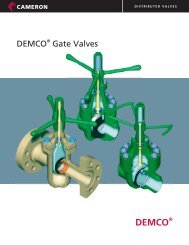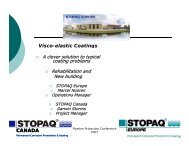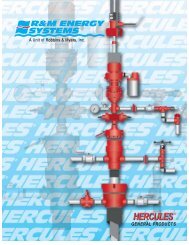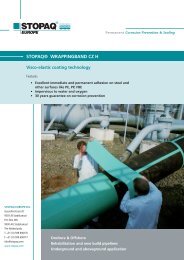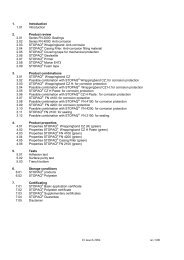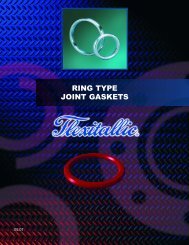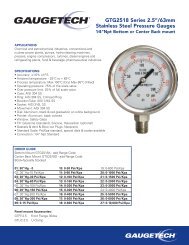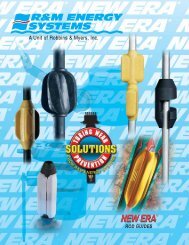Welcome to the Next Generation of Sealing ... - CE Franklin Ltd.
Welcome to the Next Generation of Sealing ... - CE Franklin Ltd.
Welcome to the Next Generation of Sealing ... - CE Franklin Ltd.
Create successful ePaper yourself
Turn your PDF publications into a flip-book with our unique Google optimized e-Paper software.
Ring Type Joints<br />
How They Work<br />
Under axial compressive load, ring type joints plastically deform and flow in<strong>to</strong> <strong>the</strong> irregularities <strong>of</strong> <strong>the</strong> flange groove. Since <strong>the</strong> load<br />
bearing area <strong>of</strong> <strong>the</strong> ring type joint is relatively small, very high surface stresses result between <strong>the</strong> sealing faces <strong>of</strong> <strong>the</strong> ring type joint<br />
and <strong>the</strong> groove. These stresses are fur<strong>the</strong>r increased on <strong>the</strong> Style RX and BX rings which allows for very high internal pressures <strong>to</strong> be<br />
sealed.<br />
Since ring type joints are solid metal, <strong>the</strong>ir recovery characteristics are poor. The seal is maintained by <strong>the</strong> action <strong>of</strong> axial load upon<br />
<strong>the</strong> gasket.<br />
Surface Finish Requirements<br />
With all metal <strong>to</strong> metal type seals, it is imperative that <strong>the</strong> gasket and groove sealing faces are free from indentations, score marks,<br />
<strong>to</strong>ol/chatter marks and o<strong>the</strong>r imperfections. The surface finish <strong>of</strong> <strong>the</strong> gasket and groove sealing faces is also critical and should not<br />
exceed <strong>the</strong> following:<br />
Style R and RX<br />
Style BX<br />
63 microinches Ra maximum (1.6 micrometer Ra)<br />
32 microinches Ra maximum (0.8 micrometer Ra)<br />
Reuse<br />
Ring type joints are designed <strong>to</strong> have a limited amount <strong>of</strong> positive interference, which ensures that <strong>the</strong> ring type joint seats correctly<br />
in<strong>to</strong> <strong>the</strong> groove on compression. Their reuse is not recommended for two reasons:<br />
• The initial seating <strong>of</strong> <strong>the</strong> gasket will be impaired.<br />
• When <strong>the</strong> gasket is plastically deformed, work hardening <strong>of</strong> <strong>the</strong> external metal surface occurs. This may result in<br />
permanent damage <strong>to</strong> <strong>the</strong> groove.<br />
Hardness <strong>of</strong> Materials<br />
On compression <strong>of</strong> <strong>the</strong> flange assembly, it is imperative that <strong>the</strong> ring type joint be significantly s<strong>of</strong>ter than <strong>the</strong> flange groove so that <strong>the</strong><br />
gasket plastically deforms and not <strong>the</strong> groove. The use <strong>of</strong> harder ring type joints can result in flange groove damage. For this reason,<br />
ring type joints are supplied with <strong>the</strong> following maximum hardness values:<br />
Maximum Hardness<br />
Material Werks<strong>to</strong>ff Identification<br />
Number Brinell* Rockwell B†<br />
S<strong>of</strong>t Iron 90 56 D<br />
Low Carbon Steel 120 68 S<br />
4 - 6% Chrome 1/2% Moly. 130 72 F5<br />
Type 304 Stainless Steel 1.4301 160 83 S304<br />
Type 316 Stainless Steel 1.4401 160 83 S316<br />
Type 347 Stainless Steel 1.4550 160 83 S347<br />
Type 410 Stainless Steel 1.4006 170 86 S410<br />
* Measured with 3000Kg load except s<strong>of</strong>t iron which is measured with 500Kg load<br />
† Measured with 100 Kg load and 1/16” diameter ball.<br />
Some materials can be supplied with NA<strong>CE</strong> certification on request.<br />
Protective Coating<br />
In accordance with API Specifications, s<strong>of</strong>t iron, low carbon steel, and o<strong>the</strong>r ferrous materials ring type joints are protected from corrosion<br />
with electroplated zinc <strong>to</strong> a maximum thickness <strong>of</strong> 0.0003”. Alternative material coatings can be supplied on request.<br />
34<br />
<strong>Welcome</strong> <strong>to</strong> <strong>the</strong> <strong>Next</strong> <strong>Generation</strong> <strong>of</strong> <strong>Sealing</strong> Technology<br />
®



